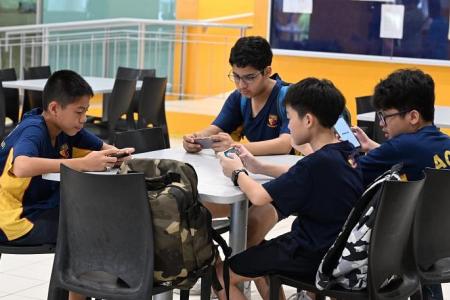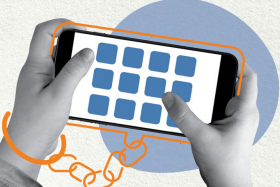Schools impose phone bans to reduce distractions
At the beginning of each school day, students at Queensway Secondary School have to keep their mobile phones in a “locker”. On most days, they do not have access to their phones until at least six hours later, when their last lesson ends.
The shared locker is placed at the front of the classroom, and teachers ensure that all students keep their mobile phones there until they are ready to be dismissed from school.
The school’s principal, Ms Audrey Chen Li Ying, said parents are generally supportive of the policy, which took effect in 2019. Parents are briefed on the policy when their children join the school in Secondary 1.
Said Ms Chen: “This measure helps students avoid being distracted by their phones during lessons and encourages social interaction with their peers during breaks.”
Amid mounting research showing the relationship between screen time on smartphones and mental health issues in youth, schools in Singapore have in recent years stepped up measures to curb the usage of smartphones.
Singapore is not alone. Others like France, Finland and China have already banned the use of mobile phones in schools.
In 2023, the United Nations called for a global ban on smartphones in schools arguing that they can disrupt students’ learning and affect their mental health.
Measures to deal with device usage in Singapore are expected to be released in the coming months.
In response to queries from The Straits Times, a spokesman for the Ministry of Education (MOE) said that schools here have rules and routines in place to manage students’ use of mobile phones during curriculum hours, which are appropriate for the school level.
These include dedicated mobile phone storage spaces in classes or at the general office where students deposit their phones before the start of lessons.
He added that schools may restrict the use of mobile devices to designated areas or times, like during recess, after school or at the foyer.
At Anglo-Chinese School (ACS) (Barker Road), students have to keep their devices in their personal lockers during the entire school day. If they are caught with their phones, the devices get confiscated for one month.
Madam Fong Chee Sing, 47, who has been teaching English language at ACS (Barker Road) for 20 years, said that bringing mobile phones into schools has changed the way students interact with one another.
Before, students would talk more to one another and there was a lot more play and in-person interaction, she said. Now, it is more common for them to play video and online games, and have conversations about these games with friends regularly.
The school’s head of student management, Mr Mohamad Azhar Ibrahim, 38, said that when he joined the school in 2011, the rules were stricter, as the penalty for being found with a phone during school hours was confiscation for three months.
“Parents use (the phone) all the time to get in contact with the student... They use it to monitor them. They use it to contact them. And it was getting quite difficult for us to have them go without the phone for quite some time,” he said.
Mr Azhar said that he currently has about 30 confiscated phones in his possession.
ACS (Barker Road) Secondary 2 student, Ng Jun Yi, 14, said locking up their phones helps him and his peers stay focused during lessons by minimising distractions, but he feels the rule should be relaxed during recess.
“I would like to use my phone during break times or recess, because during those times I want to relax, and I want to talk to my friends from other schools,” he said.
Some schools like Swiss Cottage Secondary do not require students to lock up their phones.
Previously, students at the school could have their phones switched on and with them during lessons. Since end-June, students have had to turn off their mobile phones during lessons, and are not permitted to use them during recess or lunch breaks.
The new rule has resulted in students paying more attention in class, said Ms Gina Hiu, 30, an English language teacher at Swiss Cottage Secondary.
In the past, students would be distracted by their phones, she said, especially if the vibration mode was switched on. “They may find the need to check notifications, even if they are not urgent.
MOE said that schools’ rules and routines are shared with parents through platforms such as meet-the-parents engagement sessions and via letters.
“They (rules and routines) are meant to enable students to learn values and self-management skills, as well as be encouraged to engage in learning opportunities beyond the use of devices, such as hands-on inquiry, real-life explorations and outdoor experience,” said the MOE spokesman.
Get The New Paper on your phone with the free TNP app. Download from the Apple App Store or Google Play Store now


